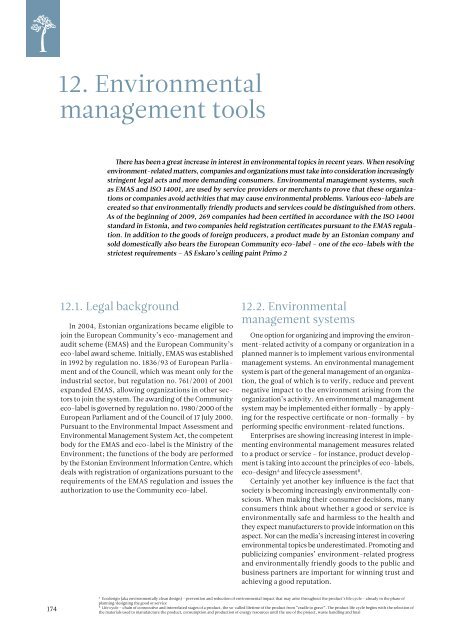ESTONIAN ENVIRONMENTAL REVIEW 2009
ESTONIAN ENVIRONMENTAL REVIEW 2009
ESTONIAN ENVIRONMENTAL REVIEW 2009
You also want an ePaper? Increase the reach of your titles
YUMPU automatically turns print PDFs into web optimized ePapers that Google loves.
12. Environmental<br />
management tools<br />
There has been a great increase in interest in environmental topics in recent years. When resolving<br />
environment-related matters, companies and organizations must take into consideration increasingly<br />
stringent legal acts and more demanding consumers. Environmental management systems, such<br />
as EMAS and ISO 14001, are used by service providers or merchants to prove that these organizations<br />
or companies avoid activities that may cause environmental problems. Various eco-labels are<br />
created so that environmentally friendly products and services could be distinguished from others.<br />
As of the beginning of <strong>2009</strong>, 269 companies had been certified in accordance with the ISO 14001<br />
standard in Estonia, and two companies held registration certificates pursuant to the EMAS regulation.<br />
In addition to the goods of foreign producers, a product made by an Estonian company and<br />
sold domestically also bears the European Community eco-label – one of the eco-labels with the<br />
strictest requirements – AS Eskaro’s ceiling paint Primo 2<br />
12.1. Legal background<br />
In 2004, Estonian organizations became eligible to<br />
join the European Community’s eco-management and<br />
audit scheme (EMAS) and the European Community’s<br />
eco-label award scheme. Initially, EMAS was established<br />
in 1992 by regulation no. 1836/93 of European Parliament<br />
and of the Council, which was meant only for the<br />
industrial sector, but regulation no. 761/2001 of 2001<br />
expanded EMAS, allowing organizations in other sectors<br />
to join the system. The awarding of the Community<br />
eco-label is governed by regulation no. 1980/2000 of the<br />
European Parliament and of the Council of 17 July 2000.<br />
Pursuant to the Environmental Impact Assessment and<br />
Environmental Management System Act, the competent<br />
body for the EMAS and eco-label is the Ministry of the<br />
Environment; the functions of the body are performed<br />
by the Estonian Environment Information Centre, which<br />
deals with registration of organizations pursuant to the<br />
requirements of the EMAS regulation and issues the<br />
authorization to use the Community eco-label.<br />
12.2. Environmental<br />
management systems<br />
One option for organizing and improving the environment-related<br />
activity of a company or organization in a<br />
planned manner is to implement various environmental<br />
management systems. An environmental management<br />
system is part of the general management of an organization,<br />
the goal of which is to verify, reduce and prevent<br />
negative impact to the environment arising from the<br />
organization’s activity. An environmental management<br />
system may be implemented either formally – by applying<br />
for the respective certificate or non-formally – by<br />
performing specific environment-related functions.<br />
Enterprises are showing increasing interest in implementing<br />
environmental management measures related<br />
to a product or service – for instance, product development<br />
is taking into account the principles of eco-labels,<br />
eco-design A and lifecycle assessment B .<br />
Certainly yet another key influence is the fact that<br />
society is becoming increasingly environmentally conscious.<br />
When making their consumer decisions, many<br />
consumers think about whether a good or service is<br />
environmentally safe and harmless to the health and<br />
they expect manufacturers to provide information on this<br />
aspect. Nor can the media’s increasing interest in covering<br />
environmental topics be underestimated. Promoting and<br />
publicizing companies’ environment-related progress<br />
and environmentally friendly goods to the public and<br />
business partners are important for winning trust and<br />
achieving a good reputation.<br />
174<br />
A<br />
Ecodesign (aka environmentally clean design) – prevention and reduction of environmental impact that may arise throughout the product’s life cycle – already in the phase of<br />
planning/designing the good or service<br />
B<br />
Life cycle – chain of consecutive and interrelated stages of a product, the so-called lifetime of the product from “cradle to grave”. The product life cycle begins with the selection of<br />
the materials used to manufatcture the product, consumption and production of energy resources until the use of the project, waste handling and final

















